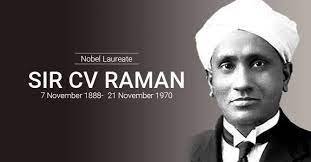Biography of C.V. Raman – The Nobel Laureate Scientist
Chandrasekhara Venkata Raman, widely known as C.V. Raman, was a renowned Indian physicist who left an indelible mark on the world of science. Born on November 7, 1888, in Tiruchirapalli, India, C.V. Raman’s contributions to the field of physics earned him the prestigious Nobel Prize in 1930. His groundbreaking work in the study of light scattering, famously known as the Raman Effect, has had a profound impact on the scientific community.

Why this News is Important
Scientific Prowess: C.V. Raman’s life and work are of utmost importance, especially for students aspiring for various government positions. His accomplishments serve as an inspiration for those pursuing careers in the civil services, teaching, or any field that demands a strong foundation in science. His journey from a small town in India to winning the Nobel Prize showcases the power of determination and dedication.
Global Recognition: The Nobel Prize in Physics in 1930 marked a significant moment in Indian scientific history. This recognition brought not only glory to the nation but also emphasized the importance of Indian scientists in the global context. It’s a testament to the potential of Indian scholars in various fields, encouraging students to dream big and contribute to the nation’s growth.
Historical Context
C.V. Raman’s scientific journey began with his extensive research on light scattering. In 1928, while working at the Indian Association for the Cultivation of Science in Kolkata, he made the groundbreaking discovery that would later be named the “Raman Effect.” This phenomenon revealed the shift in wavelength of scattered light when it interacts with molecules. His findings opened up new avenues in the study of molecular structure and quantum mechanics, revolutionizing the field of physics.
Raman’s pioneering work paved the way for various applications, including the analysis of chemical compounds and the study of planetary atmospheres. His contributions went far beyond theoretical physics, impacting diverse disciplines.
Key Takeaways from C.V. Raman’s Biography
| Serial Number | Key Takeaway |
|---|---|
| 1 | C.V. Raman was awarded the Nobel Prize in 1930 for his discovery of the Raman Effect, a pivotal breakthrough in the field of physics. |
| 2 | His journey from a small town in India to becoming a globally recognized scientist serves as an inspiration for aspiring students. |
| 3 | The Raman Effect has numerous practical applications, such as analyzing chemical compositions and understanding planetary atmospheres. |
| 4 | C.V. Raman’s work emphasized the importance of Indian scientists in the global scientific community. |
| 5 | His legacy continues to influence and inspire young minds to pursue careers in science, research, and innovation. |
Important FAQs for Students from this News
Q: What is the Raman Effect, and why is it significant?
A: The Raman Effect, discovered by C.V. Raman, is the phenomenon where light undergoes a change in wavelength when it interacts with molecules. It’s important because it revolutionized the study of molecular structures and has practical applications in various fields.
Q: How did C.V. Raman’s work impact the global scientific community?
A: C.V. Raman’s Nobel Prize win in 1930 highlighted the importance of Indian scientists on the global stage, encouraging students to excel in their respective fields.
Q: What is the historical context of C.V. Raman’s scientific journey?
A: Raman’s journey started with his extensive research on light scattering, eventually leading to his groundbreaking discovery of the Raman Effect in 1928.
Q: How can C.V. Raman’s life story inspire students preparing for government exams?
A: C.V. Raman’s journey from a small town in India to a Nobel Laureate scientist serves as a source of inspiration for students, showcasing the power of determination and dedication.
Q: Can you provide more examples of practical applications of the Raman Effect?
A: The Raman Effect is used to analyze chemical compositions, study planetary atmospheres, and even in fields like medicine and materials science.
Some Important Current Affairs Links


















 Exciting News!
Exciting News!  Join Our Telegram Channel Now!
Join Our Telegram Channel Now!
 Join our Telegram channel for a thrilling adventure into the world of daily current affairs.
Join our Telegram channel for a thrilling adventure into the world of daily current affairs. 
 Don’t miss out on the latest updates and insights! Click to join now and be part of the knowledge revolution!
Don’t miss out on the latest updates and insights! Click to join now and be part of the knowledge revolution! 
